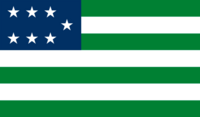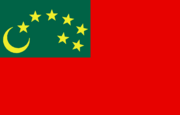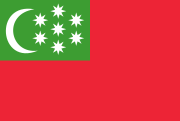
The national flag of Azerbaijan, often referred to in Azerbaijani as üçrəngli bayraq, is a horizontal tricolour that features three equally sized bars of bright blue, red, and green; a white crescent; and a centred eight-pointed star. The flag has become the predominant and most recognizable symbol of Azerbaijan. The bright blue represents Azerbaijan's Turkic heritage, the red represents progress, and the green represents Islam, which is Azerbaijan's majority religion.

The national flag of Malaysia, also known as the Stripes of Glory, is composed of a field of 14 alternating red and white stripes along the fly and a blue canton bearing a crescent and a 14-point star known as the Bintang Persekutuan. The 14 stripes, of equal width, represent the equal status in the federation of the 13 member states and the federal territories, while the 14 points of the star represent the unity among these entities. The crescent represents Islam, the country's state religion; the blue canton symbolises the unity of the Malaysian people; the yellow of the star and crescent is the royal colour of the Malay rulers. It is in the stars and stripes and the flag families.

The flag of Tunisia is a rectangular panel of red color with an aspect ratio of 2:3. In the center of the cloth in a white circle is placed a red crescent, surrounding a red five-pointed star on three sides. The Tunisian Bey Hussein II decided to create a flag for Tunisia, close in appearance to the modern one, after the Battle of Navarino on 20 October 1827; in 1831 he was officially approved. In that form, the flag existed during the French protectorate, and on 1 June 1959, it was proclaimed the state flag of the Republic of Tunisia. On 30 June 1999, the proportions and design of the flag were clarified by a special law. The general appearance of the flag remained virtually unchanged.

The flag of Bosnia and Herzegovina contains a medium blue field with a yellow right triangle separating said field, and there are seven full five-pointed white stars and two half stars top and bottom along the hypotenuse of the triangle.

The flag of the Central African Republic was officially adopted in 1958. It has been retained since that time with the same design, four horizontal stripes of blue, white, green and yellow, and a single vertical band of red, with a yellow five-pointed star in the upper left corner.

The national flag of Kazakhstan, also called the Kazakh flag, was adopted on 4 June 1992, replacing the flag of the Kazakh Soviet Socialist Republic. The flag was designed by Shaken Niyazbekov.

The national flag of Tajikistan was adopted in November 1992, replacing the flag of the Tajik Soviet Socialist Republic of 1953. The flag features Pan-Iranian colors in a horizontal tricolor of red, white and green, with a yellow crown surmounted by an arc of seven stars at the centre. It has a width ratio of 2:3:2. The tricolor preserves the choice of colors in the former Tajik Soviet flag, as well as the 1:2 proportions.

The flag of Turkmenistan features a white crescent and five stars representing the five regions of the country and the Five Pillars of Islam. Placed upon a green field is a symbolic representation of the country's famous carpet industry. It was introduced as the flag of Turkmenistan on 27 September 1992 to replace the Soviet-era flag which consisted of a red background with two light blue bars in the middle. The modified version with a 2:3 ratio was adopted on 23 January 2001. State Flag and Constitution Day is celebrated on 18 May.

In vexillography, the canton is a rectangular emblem placed at the top left of a flag, usually occupying up to a quarter of a flag's area. The canton of a flag may be a flag in its own right. For instance, British ensigns have the Union Jack as their canton, as do their derivatives such as the national flags of Australia and New Zealand.
Abkhazia is a region in the Caucasus that is under the effective control of the partially recognised self-declared Republic of Abkhazia. The de jure majority internationally recognized Autonomous Republic of Abkhazia claims to be its legitimate government.

The Mountainous Republic of the Northern Caucasus (MRNC), also referred to as the United Republics of the North Caucasus, Mountain Republic, or the Republic of the Mountaineers, was a state in Eurasia and encompassing the entirety of the North Caucasus that emerged during the Russian Civil War and existed from 1918 to 1922. It formed as a consolidation of various Caucasian ethnic groups, including the Circassians, Chechens, Karachays, Ossetians, Balkars, Ingush, and Dagestanis.
Abkhazia is a region in the Caucasus that is under the effective control of the partially recognised self-declared Republic of Abkhazia. The de jure majority internationally recognized Autonomous Republic of Abkhazia claims to be its legitimate government.

Some of the colonies, protectorates and mandates of the French Colonial Empire used distinctive colonial flags. These most commonly had a French Tricolour in the canton.

The Star of India refers to a group of flags used during the period of the British Raj in the Indian subcontinent. India had a range of flags for different purposes during its existence. The Princely states had their own flags which were to be flown alongside the British flag as a symbol of suzerainty. The official state flag for use on land was the Union Flag of the United Kingdom and it was this flag that was lowered on Independence Day in 1947. The flag of the governor-general of India was defaced with the Star of India. The civil ensign and naval ensign were the Red Ensign or Blue Ensign, respectively, defaced with the Star of India emblem.
The flag and the coat of arms of Johor are state symbols of Johor, Malaysia. Like other states of Malaysia with Malay royalties, the state symbols of Johor are influenced by Johor's royalties, as well as Islam and the political and natural features of the state.

The coat of arms of the Chechen Republic is the official symbol of the Chechen Republic. Approved by acting President of Chechnya Sergey Abramov on 22 June 2004.
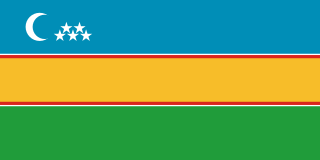
The flag of Karakalpakstan is one of the official symbols of Karakalpakstan, an autonomous republic within Uzbekistan. It was designed from a sketch by Karakalpak artist Zhollybai Izentaev. The flag is based on the flag of Uzbekistan.
The flag of Earth is a concept of a possible flag design meant to symbolize the planet Earth, humankind, or a possible world government.
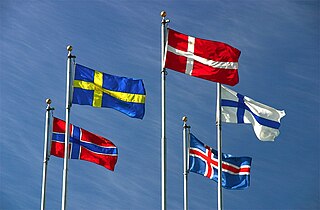
Flag families are sets of national flags with similarities in their design, often based on a shared history, culture, or influence. Families do not include flags with coincidental similarities. Flags may be in multiple flag families. Only twelve current national flags existed before the 19th century, when large-scale flag use began. Seven of these flags are the inspiration for more than 130 current national flags and ensigns.

